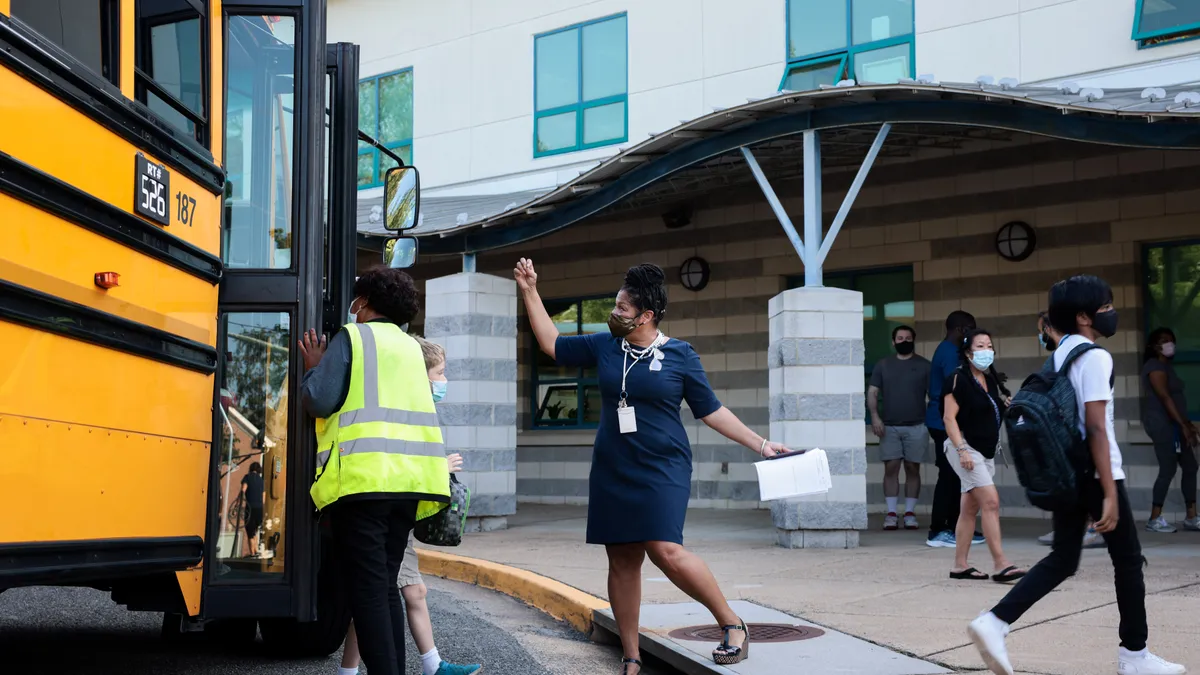A historic influx of federal funding to help K-12 schools recover from setbacks created by the worst global pandemic in modern times has largely been spent without waste or fraud so far — and it has been essential for students' academic recuperation, several education finance and policy experts said.
Fears of a dramatic and widespread fiscal cliff for school districts after the mostly flexible federal COVID-19 emergency funding dissipates also seems to be overstated, the expert said.
"I don't think it is as bad as people were concerned about, because the narrative for a while — you would have thought that every single district was going to be facing a cliff, and the reality is, not all of them are," said Elleka Yost, director of advocacy and research for the Association of School Business Officials International.
Jasmine Bolton, policy director at the Partnership for the Future of Learning, a nonprofit that has a network of over 800 stakeholders across the education field, said the federal pandemic funding has helped districts support students with disabilities, make progress in closing racial equity gaps, invest in whole-child supports and more. "I think it's important that we stress how huge, how impactful this amount of money really is and continues to be," she said.
Although there's been many positive activities supported by the COVID funding, Yost, Bolton and others also note the challenges districts now face four years after the pandemic first emerged, and as schools wean themselves from the federal emergency funds.
Some school communities face hiring freezes, school consolidations and needed facility improvements, as well as ongoing demand to support students' mental health and academic needs.
"We need continued investment, and probably continued investment that speaks to what students are continuing to experience as a result of the pandemic," Bolton said.
Saying goodbye to ESSER
The last and largest of the federal COVID-related appropriations — the American Rescue Plan fund through the Elementary and Secondary School Emergency Relief allocation — has an obligation deadline of Sept. 30 for when districts must commit to spending down the money. The ESSER-ARP spending deadline for school districts is Jan. 28, 2025.
ESSER allocations under the Coronavirus Aid, Relief, and Economic Security Act and the Coronavirus Response and Relief Supplemental Appropriations Act had earlier obligation and spending deadlines. However, some districts that received spending extensions have longer spending time frames.
In total, ESSER funds equaled $189.5 billion. By contrast, the FY 2024 appropriation from Congress to the U.S. Department of Education was $79.1 billion. Any unused COVID relief funding must be sent back to the Education Department.
"I think it's important that we stress how huge, how impactful this amount of money really is and continues to be."

Jasmine Bolton
Policy director at the Partnership for the Future of Learning
Because the obligation and spending dates were known as soon as Congress approved K-12 COVID relief monies in 2020 and 2021, school districts were able to plan for a timely off-ramp of the funds. Districts were also warned against spending practices — such as hiring many additional full-time employees — that would be unsustainable once the federal funding ran out.
Lessons learned from the American Recovery and Reinvestment Act of 2009, which helped states and localities overcome setbacks from a financial recession, also helped school systems be disciplined with COVID funding, said Noelle Ellerson Ng, associate executive director of advocacy and governance at AASA, The School Superintendents Association.
One of those lessons learned was to avoid using aid funding for recurring staffing obligations that may not be sustainable when the funding was no longer available, she said.
"There was enough of a memory to think, 'OK, here's what happened to schools after we saw ARRA go away,' and they were able to better anticipate and navigate what that ramp-down could look like," Ellerson Ng said.
Still, adjusting to non-ESSER supported budgets will likely be a challenge in many school systems, particularly for lower-income areas that received higher portions of federal emergency aid.

A survey by the Texas Association of School Business Officials conducted in the spring found that 43% of 313 districts surveyed said they were in the process of making significant budget cuts. More than half of the districts expected to end FY 2024 in a deficit.
"I think there's a general willingness to say, 'Listen, these were services or supports that we brought in because there was federal funding, and when that federal funding goes away, something has to go away,'" said Ellerson Ng, adding that those conversations about what programs should be trimmed or cut can be difficult at the local level.
Pace of spending
An Education Department dashboard on the pace of ESSER spending shows districts in states have spent between 70.5% (Nebraska) and 93.1% (Washington), as of June 30. The District of Columbia is the outlier with a spend rate of 63.5%.
Marguerite Roza, director of Edunomics Lab, an education finance research center at Georgetown University's McCourt School of Public Policy, said most school districts will spend down all their money, but some won't. As the ARP spending deadline approaches, she advises state education agencies to monitor their districts' pace of liquidation so the funds get used and not returned to the federal government.
The type of spending matters too, Roza said. For instance, schools can't pay their employees with ESSER funds beyond the obligation deadline. Only spending for vendor contracts for services or materials can go past the obligation deadline due to education finance provisions set in play before ESSER, she said.
Nearly 50% of ARP funds have been directed toward labor costs, such as hiring teachers, reading specialists and for providing salary increases, according to the Center on Budget and Policy Priorities and based on state reported data.
"The name of the game is efficiency. We're going to just have to get better at leveraging what we have to maximize value and turn away what's not working."

Marguerite Roza
Director of Edunomics Lab
And although the Education Department has created a method for states and districts to request COVID relief spending extensions, the request process can be complicated. Some states, like Minnesota, have discouraged districts from seeking spending extensions.
Because of the complexity with federal and state education finance rules, some auditors have raised concerns about the late liquidation process, according to the Council of Chief State School Officers, an organization of top state education administrators. The Education Department has said it will ensure auditors are aware of its guidance and will answer questions from states and auditors.
The Education Department's Office of Inspector General is conducting reviews of selected local and state use and planning of ESSER funds and discovered that most were meeting allowable requirements.
Yost said grant managers, district CFOs and district finance teams "really want to do right by kids. They really want to make sure that these dollars reflect the good news, and help students with not just navigating the challenges of the pandemic but recovering and getting on a better path after the fact."
Efficient budgeting
While severe and universal fiscal cliffs are unlikely as ESSER funding goes away, Yost said, there will be fiscal slides in many areas, causing school systems to adjust to a post-ESSER reality.
Roza said school finance decisions should be made by analyzing data to see what investments are helping students academically and socially — and what aren't. For instance, if math scores are low, schools should look at preserving investments in math instruction and consider slimming costs in other areas.
"Districts are going to have to think about compensation differently going forward, because if they are trying to shrink their workforce, then you don't do the big across-the-board raises in the name of retention," Roza said. Rather, raises given for retention purposes should be targeted to those positions that are hard to staff, such as math, special education and in high-poverty schools, or where the academic needs are, she said.
Likewise, if districts are faced with fiscal decisions that include closing or consolidating schools, they should base those decisions on cost and performance data, Roza said.
"If you were going to shrink your footprint, you would normally, in most industries, look at performance first, and try to hold on to what's working, and maybe reduce what's not working," she said. "So we encourage district leaders to just certainly be eyes wide open on that."
Roza added, "The name of the game is efficiency. We're going to just have to get better at leveraging what we have to maximize value and turn away what's not working.”







 Dive Awards
Dive Awards












